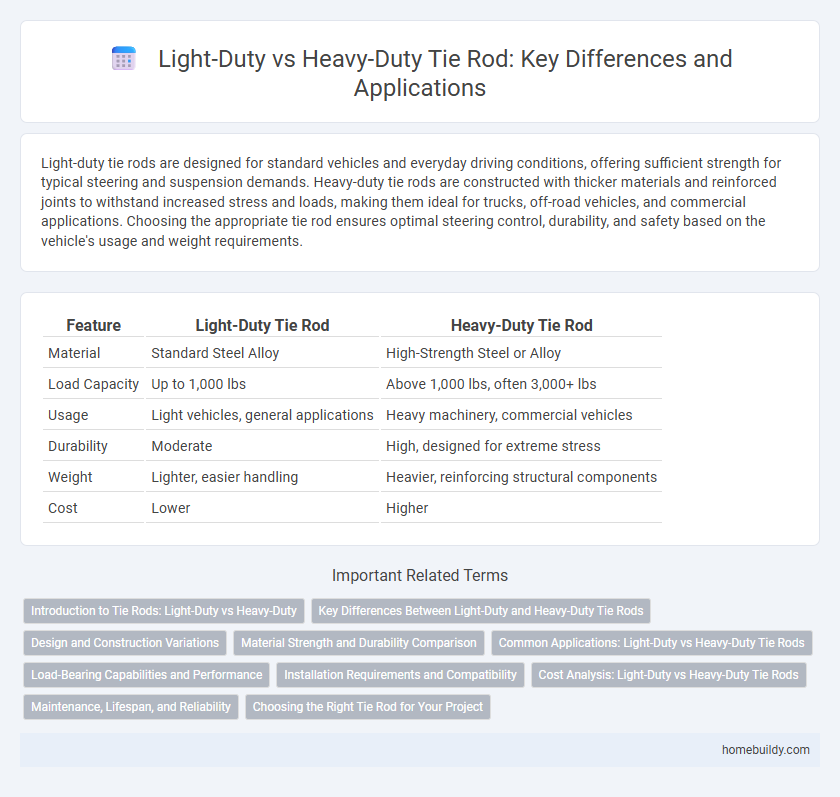Light-duty tie rods are designed for standard vehicles and everyday driving conditions, offering sufficient strength for typical steering and suspension demands. Heavy-duty tie rods are constructed with thicker materials and reinforced joints to withstand increased stress and loads, making them ideal for trucks, off-road vehicles, and commercial applications. Choosing the appropriate tie rod ensures optimal steering control, durability, and safety based on the vehicle's usage and weight requirements.
Table of Comparison
| Feature | Light-Duty Tie Rod | Heavy-Duty Tie Rod |
|---|---|---|
| Material | Standard Steel Alloy | High-Strength Steel or Alloy |
| Load Capacity | Up to 1,000 lbs | Above 1,000 lbs, often 3,000+ lbs |
| Usage | Light vehicles, general applications | Heavy machinery, commercial vehicles |
| Durability | Moderate | High, designed for extreme stress |
| Weight | Lighter, easier handling | Heavier, reinforcing structural components |
| Cost | Lower | Higher |
Introduction to Tie Rods: Light-Duty vs Heavy-Duty
Light-duty tie rods are designed for smaller vehicles and applications requiring less tensile strength, typically made from lighter materials such as aluminum or mild steel. Heavy-duty tie rods are constructed from high-strength steel alloys to withstand greater stress and load, commonly used in trucks, off-road vehicles, and industrial machinery. The choice between light-duty and heavy-duty tie rods depends on factors like vehicle weight, load capacity, and operating conditions, impacting durability and performance.
Key Differences Between Light-Duty and Heavy-Duty Tie Rods
Light-duty tie rods are engineered for vehicles with lighter loads and lower stress conditions, typically found in passenger cars and small trucks, featuring thinner steel construction and smaller diameter rods for ease of steering precision. Heavy-duty tie rods are built to withstand higher torque and impact forces, often used in commercial trucks and off-road vehicles, incorporating reinforced materials, thicker shafts, and enhanced corrosion resistance to endure harsh environments and heavy workloads. The key differences lie in load capacity, material strength, size, and durability, directly influencing vehicle steering stability and maintenance frequency.
Design and Construction Variations
Light-duty tie rods feature thinner cross-sections and use lightweight materials such as aluminum alloys for applications with lower stress requirements, prioritizing flexibility and ease of installation. Heavy-duty tie rods incorporate thicker, high-strength steel and reinforced end fittings designed to withstand higher loads and intense mechanical stress in demanding industrial environments. Variations in design include differences in thread size, rod length, and protective coatings to optimize durability and performance specific to operational demands.
Material Strength and Durability Comparison
Light-duty tie rods are typically manufactured from mild steel or low-grade alloys, providing sufficient strength for applications with minimal stress and lighter loads. Heavy-duty tie rods use high-strength alloy steels or heat-treated materials, offering superior tensile strength and enhanced resistance to wear, corrosion, and fatigue under demanding conditions. The material strength difference significantly impacts durability, with heavy-duty tie rods maintaining structural integrity longer in high-stress environments.
Common Applications: Light-Duty vs Heavy-Duty Tie Rods
Light-duty tie rods are commonly used in passenger vehicles, bicycles, and light machinery where moderate stress and lower load capacities are sufficient. Heavy-duty tie rods are essential in commercial trucks, construction equipment, and industrial machinery, designed to withstand high torque, heavy loads, and harsh operating conditions. Selecting the appropriate tie rod type ensures optimal vehicle performance, safety, and durability based on application demands.
Load-Bearing Capabilities and Performance
Light-duty tie rods are designed for applications with lower load requirements, typically supporting weights under 1,000 pounds, making them ideal for lighter machinery and automotive setups. Heavy-duty tie rods feature reinforced construction and high-strength materials, enabling them to withstand loads exceeding 5,000 pounds, which is essential for industrial equipment and heavy vehicles. The superior load-bearing capacity of heavy-duty tie rods ensures enhanced performance, durability, and safety under extreme stress and dynamic conditions.
Installation Requirements and Compatibility
Light-duty tie rods typically require simpler installation procedures and are compatible with standard passenger vehicles, featuring lighter materials and smaller dimensions. Heavy-duty tie rods necessitate robust mounting hardware and precise alignment to handle increased stress loads, making them suitable for trucks and off-road vehicles with reinforced steering systems. Compatibility depends on vehicle weight class and suspension design, ensuring that the tie rod meets torque and flexibility requirements for optimal performance.
Cost Analysis: Light-Duty vs Heavy-Duty Tie Rods
Light-duty tie rods generally offer a lower upfront cost, making them suitable for vehicles with standard operational demands and lighter weights. Heavy-duty tie rods, although more expensive initially, provide enhanced durability and longevity, reducing replacement frequency and maintenance expenses in heavy-load or off-road conditions. The overall cost analysis favors heavy-duty tie rods in demanding applications due to their superior strength and reliability, despite higher initial investment.
Maintenance, Lifespan, and Reliability
Light-duty tie rods typically require more frequent maintenance and inspections due to their lower load-bearing capacity and susceptibility to wear under stress, resulting in a shorter lifespan of around 50,000 to 70,000 miles. Heavy-duty tie rods feature reinforced materials and robust construction that enhance durability, extending lifespan beyond 100,000 miles with less frequent maintenance needs. The increased reliability of heavy-duty tie rods makes them ideal for vehicles operating in demanding conditions or carrying heavy loads, reducing the risk of steering failures and costly repairs.
Choosing the Right Tie Rod for Your Project
Light-duty tie rods are ideal for small-scale projects requiring moderate tensile strength and flexibility, typically used in residential construction or light machinery applications. Heavy-duty tie rods offer superior durability and load-bearing capacity, making them essential for industrial, commercial, or heavy construction projects demanding maximum structural support. Selecting the right tie rod depends on the specific load requirements, environmental conditions, and safety factors to ensure optimal performance and longevity in your project.
light-duty tie rod vs heavy-duty tie rod Infographic

 homebuildy.com
homebuildy.com